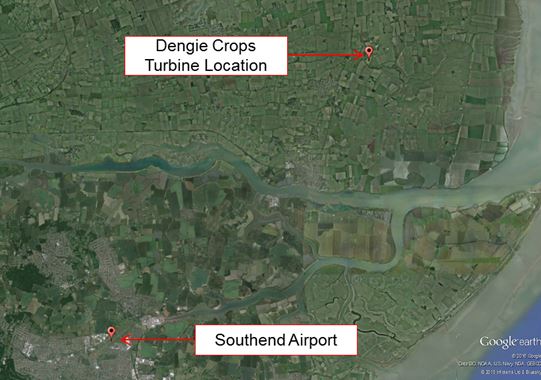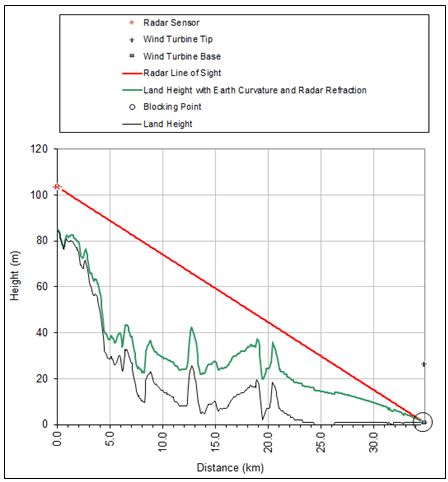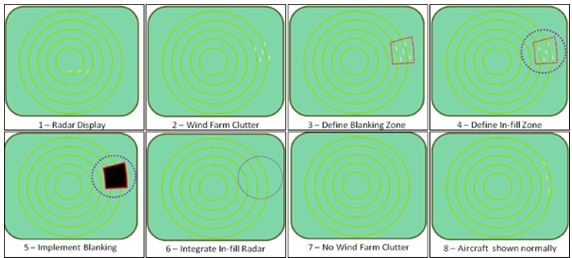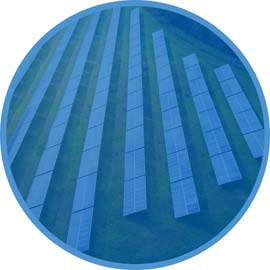Introduction
A developer was proposing the construction of a wind turbine on behalf of Dengie Crops Ltd, approximately 2km Northeast of Southminster, Essex. Pager Power’s analysis[1] had indicated that the wind turbine was likely to be visible to the Primary Surveillance Radar (PSR) at London Southend Airport.
Pager power was tasked with providing an overview of a range of mitigation solutions to be presented to the airport. This would then be used as a basis for engagement with the airport to remove an objection to the proposed Dengie Crops wind turbine.
Background
London Southend Airport is a licensed aerodrome, and is approximately 16km southwest of the proposed turbine at Dengie Crops. Safeguarding of radar operations by aerodromes can be a major hurdle for small scale wind developers to overcome. This is due to wind turbine blades creating moving radar returns or ‘clutter’ on PSR radar displays. Line of sight between the turbine and radar, and detectability of the turbine were considered.
As the analysis conducted by Pager Power demonstrated the turbine was likely to be detected by the PSR, engagement was required with London Southend Airport to remove the planning objection. Mitigation measures provided the only practicable solution to obtain planning permission for this project.
The Challenge
There were three prominent challenges associated with this project:
- Producing a range of mitigation options to mitigate the effect on the radar display.
- Engaging with London Southend Airport to consider the proposed mitigation solutions.
- Removing the planning permission objection by the Airport to the wind turbine.
The Process
The first step to overcome the planning objection was to produce a report outlining the common mitigation solutions for wind turbine returns on radar screens. In total, four options were presented to the developer. The assessed options included consideration of changes to the radar display system and changes to the turbine itself:
- Customised display solution – using a bespoke radar display product to modify the image displayed to the air traffic controller, either by dimming the image of radar returns from the turbine, or removing them altogether.
- In-fill radar coverage – installing small scale radar equipment to provide localised radar information from the vicinity of wind turbines.
- Radar Blanking – removing clutter from the display of the radar information, generally the most cost effective solution.
- Modification of wind turbine dimensions – with the appropriate modelling and analysis, a smaller turbine could be proven to produce no radar returns.
An estimation of likely feasibility and estimation of cost was given for consideration purposes. From this, the developer had the relevant options to consider.
The next stage was to engage with the airport authority at London Southend Airport in order to determine which mitigation solution would be viable. Two meetings were held with London Southend Airport.
The Solution
Potential solutions were explored based on:
- Technical Viability.
- The airports requirements.
- Other wind developments in the area
Technical discussions and correspondence with the airport were progressed with a view to removing the outstanding objection. Due to the size of the development, more expensive bespoke solutions for one turbine were not viable for the developer. However, the discussions highlighted way forward for the development to obtain planning permission.
The Result
Through consultations with London Southend Airport, a mitigation strategy was agreed for the proposed turbine at Dengie crops. This allowed planning permission to be granted on the 26th of August 2015. The objection was removed subject to a planning condition agreed between the airport and the developer, pursuant to the analysis and the technical meetings.
Pager Power has a proven track record in resolving planning objections concerning issues such as aviation, telecommunications, public safety and residential amenity.
References
[1] Pager Power, 2013, Aviation Risk Report and Aviation Risk Report Expert Commentary

Figure 1: Site and PSR location.

Figure 2: Example of a radar line of sight analysis chart

Figure 3: Representation of an in-fill mitigation solution, one of many mitigation strategies for wind developments
How can we help you today?



THE SECTORS WE SERVE




